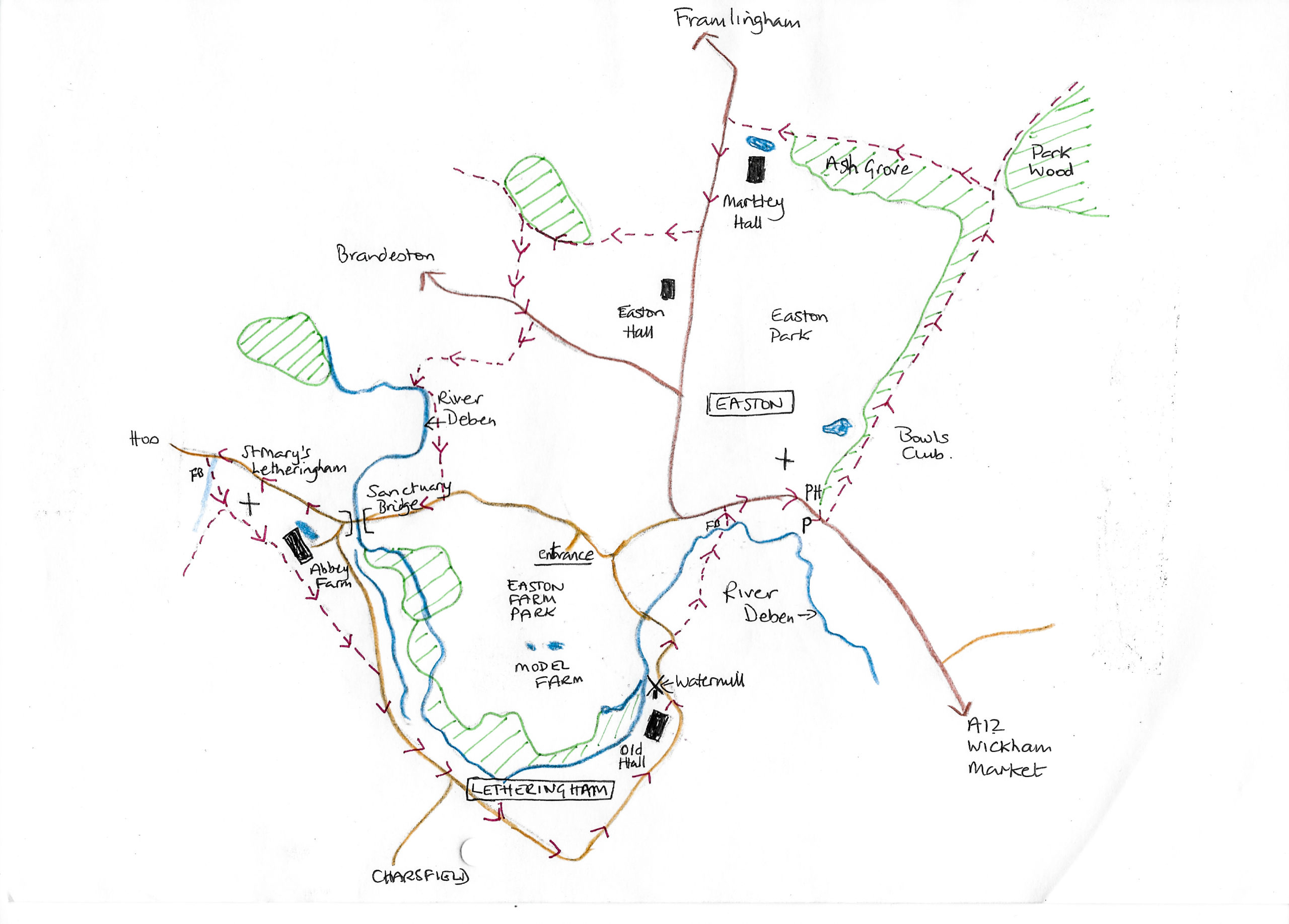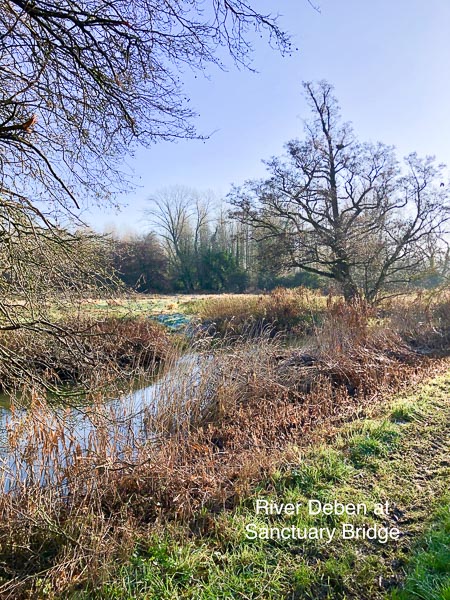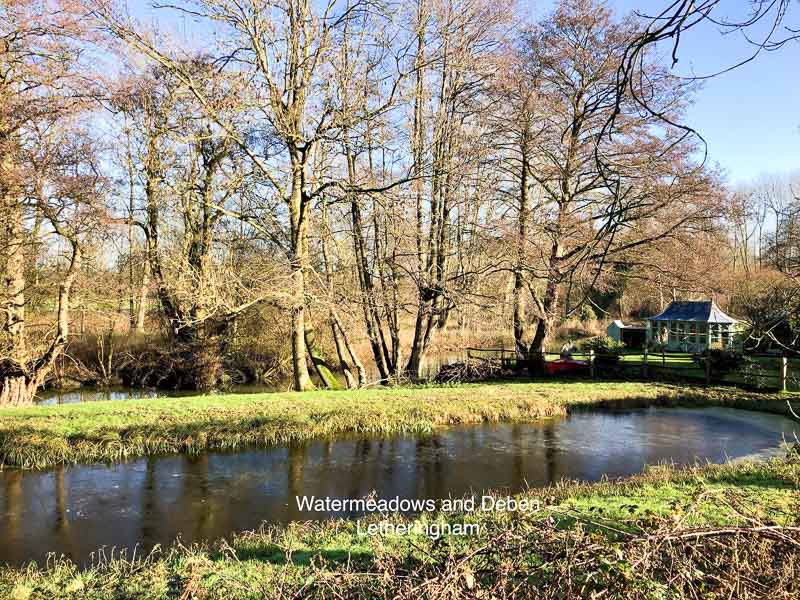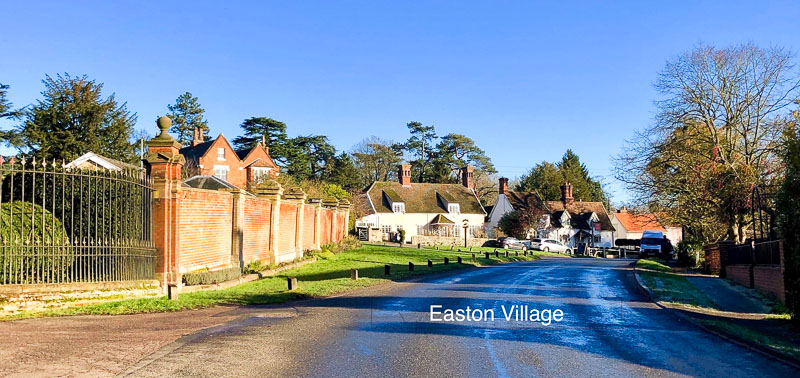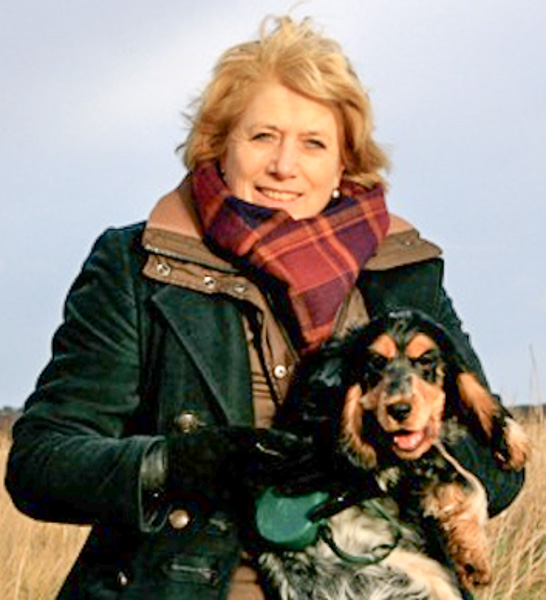By Sue Ryder Richardson
Beyond its tidal reaches, the Deben meanders through ancient villages, beside grazed water meadows, and land that has been farmed for centuries. This water has brought wealth, has succoured communities, has driven the wheels of watermills, and in its workaday practicality enabled the establishment of several ecclesiastical centres along its banks.
One such, long since ruined, sits within the walls Abbey Farm, still a working farm in Letheringham. So, with this in mind, Bobby and I set out to explore these upper reaches of the Deben on a beautiful cold, sunny day in the first week of the January lockdown. There was a palpable stillness, people were wary of going out. It made our crisp footsteps on the frozen ground, bird song in the chill air, and the occasional baying of the hounds from the Easton kennels, the only sounds.
As many of you will know, there are few footpaths upstream that run alongside the Deben: it is farming country. Small bridges cross the river here and there, and the walker will only glimpse the river’s path, note where its course meanders, by the trees scattered along the banks. This five-mile walk passes through beautiful landscape and lands touched by much fascinating history.
Turn right onto the road from the carpark in Easton Village (TM 284587), and take the signed footpath left, uphill towards the bowls club. The path will shortly follow alongside part of the Serpentine or ‘crinkle-crankle’ wall of the now demolished Easton Estate
You will need a vivid imagination to picture the setting of a Palladian mansion in some 150 acres of land. The house itself was re-erected by Sir Anthony Wingfield in 1627, from its original site on Tacket Street in Ipswich. With the decline of the fortunes of this Wingfield family, the property passed on through a succession of Earls of Rochford. It was the 5th Earl who in the late C18th, built this Serpentine wall, before their own dynasty died out, and the estate passed on once more, this time into the hands of the Scottish Dukes of Hamilton. (http://easton.onesuffolk.net/history-part-1/).
As you follow the path, you will see how the wall has fallen into complete disrepair, with large sections missing, the area is a tangle of trees and undergrowth, aptly named ‘The Wilderness’ on OS maps, this together with the ruins of the tumbling wall, seems a ripe setting for a gothic horror.
At the end of the estate wall, turn left and follow more of the ruins along the north side of Ash Grove to reach a lane. Turn left here and pass by Martley Hall. It was to Marley Hall that the parkland from the Easton Estate was transferred in the early C20th, as it became the final but rarely used home of the Hamiltons in Easton.
From the lane, take the first footpath right to reach a wood, midway along this section, take the signed path left down to a lane. At the time of walking there were no flowers in the hedgerows and ditches, but from mid-March these should be filled with spring flowers: primroses, dandelions, celandines as well as swathes of alexander and cows’ parsley, whilst the hedges will be bursting with blossom and buds. There are fine views here down into the valley and across to the church of St Mary’s, Letheringham.
On reaching the next lane turn left and then immediately right. The footpath descends to the river, where a left turn takes you onto a path that meanders alongside the Deben, turn right on reaching the road and cross over Sanctuary Bridge. It is well worth pausing here; in the quiet you may catch a flash of blue: a kingfisher, as it darts down the river, or some of the many waterbirds nesting in the reeds.
Continue on the road past the church then take the first signed footpath left. Turn immediately left to cross a footbridge and keep on the diagonal over the field towards the rare C15th gatehouse. You will find some rather awkward brick steps here to climb over the wall into the churchyard. This is the site of the Augustinian Priory founded in 1194 by William de Boville. The original Priory housed elderly, ill or possibly ‘naughty’ canons from the St Peter and St Paul Priory in Ipswich. The Augustinians, or Black Canons, were a clerical order and often known for their hospitality. (https://thehistoryjar.com/tag/black-canons/).
This Priory lasted for 350 years before its dissolution in 1537. Since that time, the grounds and buildings have been developed to include an abbey, church and a hall. Nothing remains of the church except the old nave, worth a visit for the wall painting and re-claimed statues, but the true beauty of this site is the graveyard. Like so many in Suffolk this has become a wildflower sanctuary, and in most seasons is a riot of many species of wildflowers and grasses. The garden wall of the old hall forms the northern boundary, and a vast listed barn is incorporated into the working farmyard beyond the church. (https://historicengland.org.uk/listing/the-list/list-entry/1014859).
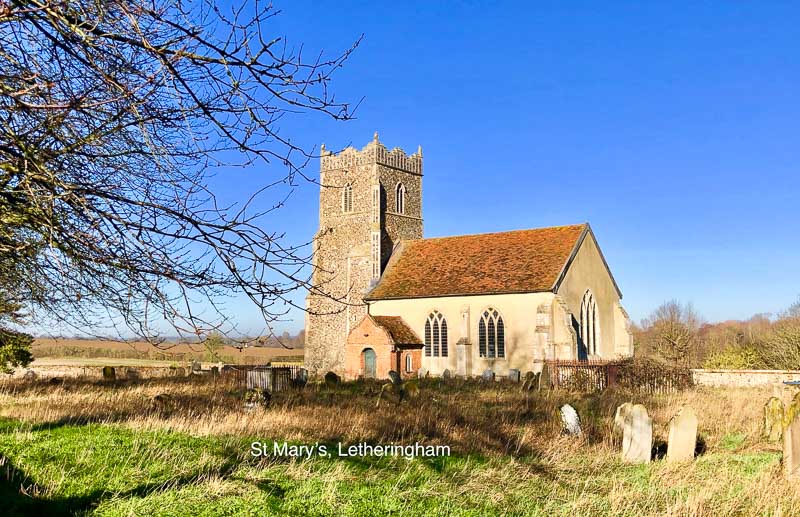 To continue on the walk, take the path out of the churchyard and keep ahead to cross into an open field, where a diagonal path takes you to a lane. Turn right here follow the meanders of the Deben into the hamlet of Letheringham. All along this road there are wonderful glimpses of the river across the water meadows and again behind the charming row of cottages.
To continue on the walk, take the path out of the churchyard and keep ahead to cross into an open field, where a diagonal path takes you to a lane. Turn right here follow the meanders of the Deben into the hamlet of Letheringham. All along this road there are wonderful glimpses of the river across the water meadows and again behind the charming row of cottages.
Pass the millstone village sign, then keep ahead as the road curves to pass by the ancient and moated Old Hall. It sits on lands noted in the Domesday book, and it is thought to be the site of an ancient church and Saxon burial ground. It was the C15th home of another branch of the Wingfield family and has a fascinating history. https://www.wingfieldfamilysociety.org/manors/letheringham-hall/
Very shortly the lane passes the C18th Letheringham Water Mill which abuts the Old Hall, it has been spectacularly preserved and is now available as holiday accommodation.
At the next corner, continue ahead, following a footpath alongside a drive, after crossing water meadows on a series of footbridges, emerge into the street at Easton beside the kennels, and opposite a well-preserved section of the ‘crinkle-crankle’ wall. Turn right and walk through the village, passing many delightful houses, some of which were created as a Mock Tudor fantasy by the 12th Duke of Hamilton for his wife, Mary.
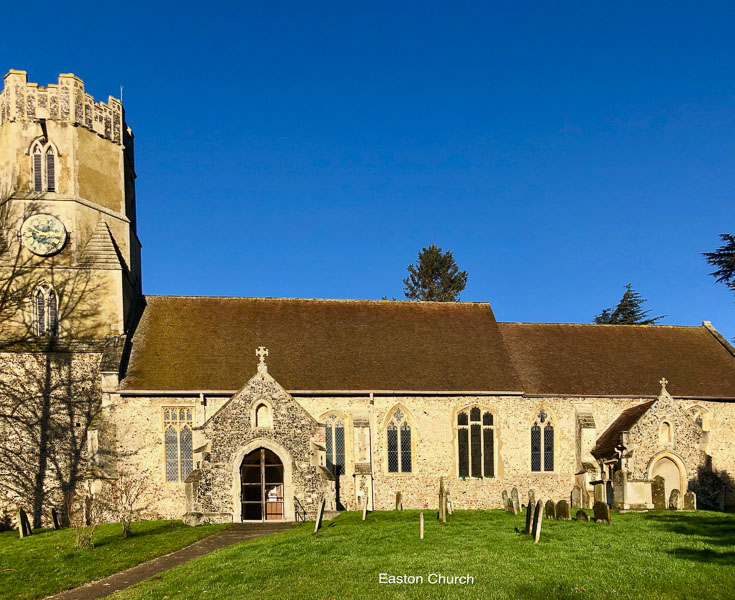 As an alternative to the route through Letheringham, I would suggest a visit to Easton Farm Park (https://www.eastonfarmpark.co.uk/), shut at the time of writing due to Covid. The park offers an exceptional walk alongside the Deben with banks of wildflowers amongst the willows and reedbeds. There is abundant birdlife, and it is not unusual to see kingfishers darting along the river.
As an alternative to the route through Letheringham, I would suggest a visit to Easton Farm Park (https://www.eastonfarmpark.co.uk/), shut at the time of writing due to Covid. The park offers an exceptional walk alongside the Deben with banks of wildflowers amongst the willows and reedbeds. There is abundant birdlife, and it is not unusual to see kingfishers darting along the river.
Easton Farm Park is a fine example of a Victorian model farm. These were created by wealthy landowners, in this case, by the 12th Duke of Hamilton in the late C19th in Easton for his wife, Mary. The estate was broken up, and the mansion finally demolished after WW1. William Kerr then bought the model farm in the 1930s and his son Jimmy converted the old dairy farm into this visitor attraction in 1974.
Sue Ryder Richardson
Born in Suffolk, I have a great love for a county that I have explored on foot for as long as I can remember. Slow travel lets me enjoy the landscape; savour its history, flora and fauna. After many years of the London commute, it is such a pleasure to be able to write walks for publication, as well other pieces. Currently I’m interested in the future development of the ‘Slow Ways’ initiative. https://slowways.uk/

